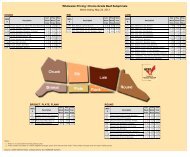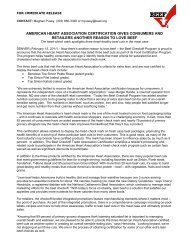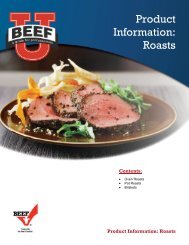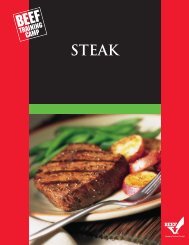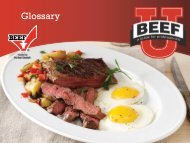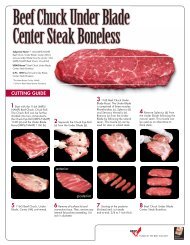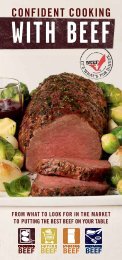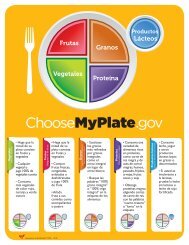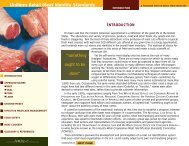Fact Sheet - Beef Foodservice
Fact Sheet - Beef Foodservice
Fact Sheet - Beef Foodservice
Create successful ePaper yourself
Turn your PDF publications into a flip-book with our unique Google optimized e-Paper software.
The requirements for Halal meat are that an animal or poultry has to be harvested in a<br />
ritual way known as Zibah. Zibah requires that animals be alive and healthy at the time<br />
of harvest, that a Muslim perform the ritual and that the carcass be drained of all blood.<br />
In addition, there are other rules and edicts that have to be followed, including Halal<br />
processing must not be done anywhere where pigs are processed (as pork is forbidden),<br />
the animal must be fed and given water prior to harvest, one animal cannot see another<br />
animal being harvested and, whenever possible, the animal should face Mecca.<br />
Products prepared by federally inspected meat packing plants identified with labels<br />
bearing references to Halal or Zabiah Halal must be handled according to these and<br />
other Islamic law and under Islamic authority.<br />
Grading<br />
The acceptability and value of beef carcasses is determined primarily by: (1) the quality<br />
of the beef, and (2) the yield of saleable beef. U.S. Department of Agriculture (USDA)<br />
grades for beef carcasses provide a system of sorting a rather heterogeneous (varied)<br />
supply of beef into smaller, more homogeneous (uniform) groups (i.e., Quality Grade<br />
Choice-Yield Grade 2) for marketing. These grades promote uniform market reporting,<br />
provide a tool for expressing and comparing value and prices, and enhance foodservice<br />
and consumer marketing.<br />
Established in 1927, the USDA meat grading program, administered by the Agricultural<br />
Marketing Service (AMS) of the USDA, sets “standards” (which are written descriptions)<br />
of quality and cutability (yield of edible meat) that are used in buying and selling meat.<br />
These standards allow livestock owners to gear production for specific grades based on<br />
market demand. Packers can segregate carcasses and cuts into groups of similar<br />
grades and retailers can buy the grades of meat appropriate for their markets. For<br />
consumers, grading provides assurance that the product conforms to an established set<br />
of standards that predict palatability. Today, in larger plants computer imaging<br />
technology assists USDA graders.<br />
There are federal grade standards for beef, veal, pork and lamb. However there are<br />
more grade designations for beef carcasses due to the wider variation in age and weight<br />
of cattle compared to other meat animals. The meat grading standards designate eight<br />
“quality” grades for beef (Prime, Choice, Select, Standard, Commercial, Utility, Cutter<br />
and Canner) and five “yield” grades (depicted numerically from 1 to 5).<br />
Only beef carcasses (not individual cuts) are graded. However, this grade designation is<br />
carried forward to all wholesale/primal and retail cuts derived from a graded carcass.<br />
Unlike meat inspection, which is mandatory, participation in the meat grading program is<br />
voluntary, and the cost of this service is paid for by the meat packers. This cost may be<br />
included in the cost of meat purchased by consumers or foodservice operators.<br />
Today, approximately 95% of all federally inspected slaughter gets a grade. Fed cattle<br />
are young cattle marketed out of feedlots after an average of 100-150 days on a grain<br />
based diet.



